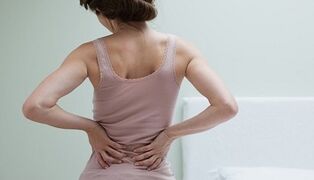
About 80 percent of adults experience low back pain and, if you also have a problem, know that you are not alone. This can be corrected. The main thing is to understand the source of the pain, but there can be many factors. We have compiled the main causes of low back pain that can cause back problems. How to relieve the disease? There are ways.
Back pain can appear at any age and with any physical condition. Therefore, there is a dull, constant or periodic pain, and there is a sudden acute attack, after which it is difficult for a person to move. Pain may appear abruptly due to weight lifting, may develop with age due to changes in the spine or as a result of an accident. A sedentary lifestyle is also a significant cause of low back pain. Especially when the day to day is not diluted with physical activity (gymnastics, swimming pool, fitness, yoga).
In most cases, low back pain is acute and of short duration or less intense, but lasts from a few days to a few weeks. In such cases, the person still does not lose his activity, the ability to move and serve himself on a daily basis.
Subacute pain is pain that persists after an acute period and lasts 4 to 12 weeks. If after that period the pain still persists, it is called chronic. Sometimes, treatment can help relieve chronic low back pain. But in some cases, the pain persists despite medical and surgical treatment.
Therefore, low back pain, the causes of which are often age-related and associated with wear and tear on the joints, discs and bones of the spine or mechanical pain:
1. sprains
This can cause severe back pain. Stretching occurs due to incorrectly rotating or lifting something. And also due to weight lifting or excessive stretching. These conditions can cause spasms in the back muscles, which also causes pain.
2. Intervertebral disc wear

One of the most common causes of back pain. A manifestation of this is the loss of disk integrity, cracks appear. On young and healthy backs, the discs allow the lower part to bend, curve and twist. But over the years, the elasticity of the discs decreases and they lose their shock absorption capacity.
3. Hernia
It may appear due to heavy lifting, poor posture, an accident, sports injury and so on. There is fluid in the center of the lumbar disc; for various reasons, it can go out and irritate the nearby nerve root. There are many nerve fibers in the disc wall and tearing the wall can cause severe pain.
4. Radiculopathy
This condition occurs due to compression, inflammation and / or damage to the spinal root. Furthermore, pressure on a nerve root results in pain, numbness or a tingling sensation that spreads to other parts of the body connected to that nerve. The problem can arise if the spinal canal narrows or if a hernia tightens the nerve root.
5. Sciatica
Compression of the sciatic nerve, which passes through the buttocks and extends to the back of the leg. This compression causes shock or burning pain in the lower back, combined with pain in the buttocks. And also in exceptional cases, when the nerve is compressed between the disc and the adjacent bone, the person may experience numbness and severe weakness in the legs. By the way, this condition appears due to a tumor or cyst that presses on the sciatic nerve or its roots.
6. Spinal stenosis
In the case of this disease, in addition to low back pain, a person may experience numbness or weakness in the legs when walking. And also with loss of sensation.
7. Scoliosis and other skeletal disorders

A person usually does not have special problems with curvature of the spine before middle age.
Low back pain is not usually associated with serious medical conditions. But you still need to be aware of its existence to have time to see a doctor in a timely manner. Defeating the diseases listed below is only possible with medical help. This:
1. Infections
These are not causes of low back pain, but they can affect the vertebrae (osteomyelitis), the intervertebral discs (discitis) or the sacroiliac joints (sacroiliitis).
2. Tumors
Sometimes a tumor appears on the back (and in certain stages, of course, there will be pain and other symptoms), but most of the time it is metastases that have spread due to cancer in other parts of the body.
3. Equine Tail Syndrome
Disease sometimes accompanied by a ruptured disk. This is because the disc material is pressed against the spinal canal and compresses the bundle of the lumbar and sacral nerve roots. In connection with this disease, a person may have problems with urination and the intestines.
4. Abdominal aortic aneurysm
This occurs when a large blood vessel that supplies blood to the abdomen, pelvis and legs becomes abnormally enlarged. In addition, low back pain can be a sign that the aorta has enlarged and there is a risk of rupture.
5. Kidney stones
Stones can cause severe pain in the lower back (usually on one side).
Other factors and causes that can cause back pain:
- Inflammatory diseases of the joints.For example, arthritis, spondylitis, spinal inflammation.
- Osteoporosis.This is a bone disease that is accompanied by a decrease in bone density and strength, which can lead to vertebral fractures.
- Endometriosis.A female disease that may be accompanied by pain in the pelvis and lower back.
- Fibromyalgia.Pain syndrome, accompanied by muscle pain and fatigue. It is chronic.

What to do with back pain?
First, you need to have a good understanding of the causes of pain. What can help in one condition will not (and perhaps even aggravate) another. And in some cases, urgent hospitalization is required. Therefore, listen to the body's signals and, if necessary, consult a doctor or take appropriate measures.
Ways to deal with low back pain:
1. You can give your back a rest after a certain period of time
Many back problems can be resolved (or alleviated) by avoiding strenuous activity. However, it is not recommended to rest for more than a few days, as too long inactivity can make treatment difficult.
2. Limited activity
This means staying active, but avoiding actions and attitudes that increase the pain. For example, if sitting in the car or at the table for long periods makes the pain worse, set a timer to get up every 20 minutes and walk or stretch gently. Minimizing the activities and positions that make the pain worse will help prevent or relieve painful cramps and speed up the healing process.
3. Cold / heat therapy
A hot bath, heating pads and body wrap are suitable for relaxing tense muscles and improving blood flow. If the back pain is caused by inflammation, you can try applying ice or cold compresses to reduce the swelling. It is important to protect the skin during procedures to prevent damage to tissues.
4. Pain medications
The most common over-the-counter drugs are anti-inflammatory drugs that relieve low back pain caused by swollen nerves or muscles. Also in some cases, a pain reliever can help. B vitamins, muscle relaxants, various gels and ointments are effective.
5. Physiotherapy
It is usually part of the treatment of low back pain. Stretching is useful: the more mobile your muscles, the better your back can move without injury. It is recommended to start slowly - stretch your lower back, buttocks, hips and legs muscles for 20-30 seconds and stop stretching if it hurts.
You also need to strengthen the muscles of the abdomen, thighs and buttocks that support the spine. Low-impact aerobic exercise increases blood flow and promotes healing of injuries without spinal concussion. For example, you can exercise on stationary bikes and elliptical trainers, walk and swim.
In fact, any exercise that keeps the heart cycle healthy for a long time is beneficial for the body. Regular physical activity is essential to maintain freedom of movement and the flexibility of a healthy spine.












































